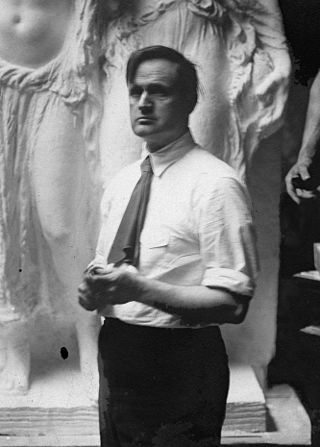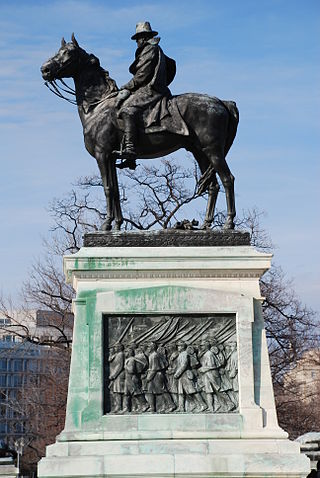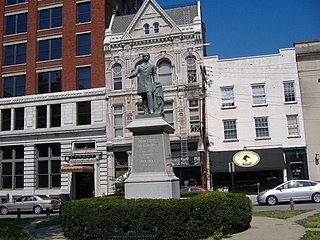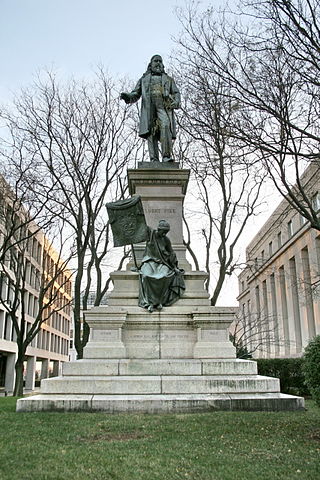
Jacob Collamer was an American politician from Vermont. He served in the U.S. House of Representatives, as Postmaster General in the cabinet of President Zachary Taylor, and as a U.S. Senator.

James Earle Fraser was an American sculptor during the first half of the 20th century. His work is integral to many of Washington, D.C.'s most iconic structures.

There are many outdoor sculptures in Washington, D.C. In addition to the capital's most famous monuments and memorials, many figures recognized as national heroes have been posthumously awarded with his or her own statue in a park or public square. Some figures appear on several statues: Abraham Lincoln, for example, has at least three likenesses, including those at the Lincoln Memorial, in Lincoln Park, and the old Superior Court of the District of Columbia. A number of international figures, such as Mohandas Gandhi, have also been immortalized with statues. The Statue of Freedom is a 19½-foot tall allegorical statue that rests atop the United States Capitol dome.

John Mason was an English-born settler, soldier, commander and Deputy Governor of the Connecticut Colony. Mason was best known for leading a group of Puritan settlers and Indian allies on a combined attack on a Pequot Fort in an event known as the Mystic Massacre. The destruction and loss of life he oversaw effectively ended the hegemony of the Pequot tribe in southeast Connecticut.

The Ulysses S. Grant Memorial is a presidential memorial in Washington, D.C., honoring American Civil War general and 18th United States President Ulysses S. Grant. It sits at the base of Capitol Hill, below the west front of the United States Capitol. Its central sculpture of Grant on horseback faces west, overlooking the Capitol Reflecting Pool and facing toward the Lincoln Memorial, which honors Grant's wartime president, Abraham Lincoln. Grant's statue is raised on a pedestal decorated with bronze reliefs of the infantry; flanking pedestals hold statues of protective lions and bronze representations of the Union cavalry and artillery. The whole is connected with marble covered platforms, balustrades, and stairs. The Grant and Lincoln memorials define the eastern and western ends, respectively, of the National Mall.

The Mystic massacre – also known as the Pequot massacre and the Battle of Mystic Fort – took place on May 26, 1637, during the Pequot War, when Connecticut colonizers under Captain John Mason and their Narragansett and Mohegan allies set fire to the Pequot Fort near the Mystic River. They shot anyone who tried to escape the wooden palisade fortress and murdered most of the village. There were between 400 and 700 Pequot civilians killed during the massacre, and the only Pequot survivors were warriors who were away in a raiding party with their sachem Sassacus.

The John C. Breckinridge Memorial, originally on the courthouse lawn of Lexington, Kentucky, was placed on the National Register of Historic Places on July 17, 1997, as part of the Civil War Monuments of Kentucky MPS. It commemorates John C. Breckinridge, who was born and died in Lexington. He was Vice President for James Buchanan and ran against Abraham Lincoln in the 1860 United States presidential election, winning nine Southern states. He served in the Confederate States Army, and was the last Confederate States Secretary of War, fleeing the country after the South lost.

The Pequot Fort was a fortified Native American village in what is now the Groton side of Mystic, Connecticut, United States. Located atop a ridge overlooking the Mystic River, it was a palisaded settlement of the Pequot tribe until its destruction by Puritan and Mohegan forces in the 1637 Mystic massacre during the Pequot War. The exact location of its archaeological remains is not certain, but it is commemorated by a small memorial at Pequot Avenue and Clift Street. The site previously included a statue of Major John Mason, who led the forces that destroyed the fort; it was removed in 1995 after protests by Pequot tribal members. The archaeological site was added to the National Register of Historic Places in 1990.

Andrew Jackson is a bronze equestrian statue by Clark Mills mounted on a white marble base in the center of Lafayette Square within President's Park in Washington, D.C., just to the north of the White House. Jackson is depicted dressed in military uniform, raising his hat with his right hand, while controlling the reins with his left hand as his horse rises on its rear legs.

Commodore John Barry is a bronze statue of John Barry, sculpted by John Boyle and designed by architect Edward Pearce Casey.

The Albert Pike Memorial is a public artwork in Washington, D.C., erected in 1901 and partially demolished by protestors in 2020.

The Hamilton Bulldogs are a major junior ice hockey team in the Ontario Hockey League (OHL) that began to play in the 2015–16 season. Based in Hamilton, Ontario, Canada, the Bulldogs play their home games at FirstOntario Centre. They were purchased by owner Michael Andlauer in March 2015 and relocated to Hamilton after 34 years in Belleville, where they were known as the Bulls. The Bulldogs won OHL championships in 2018, and 2022.

More than 160 monuments and memorials to the Confederate States of America and associated figures have been removed from public spaces in the United States, all but five since 2015. Some have been removed by state and local governments; others have been torn down by protestors.
Brandon McGee was a Connecticut state representative and former candidate for Mayor of Hartford. He served four terms in the Connecticut House of Representatives. He was interviewed by Connecticut Public Radio in August 2019.

The National Garden of American Heroes was a sculpture garden honoring "great figures of America's history" that was proposed by President Donald Trump in executive orders on July 3, 2020, and January 18, 2021. Trump first announced the idea at an Independence Day event at Mount Rushmore in Keystone, South Dakota. The sculpture garden idea was part of a series of executive orders issued by Trump in his final months in office to address conservative cultural grievances; the second of the two executive orders was issued two days before Trump's term expired. Congress never appropriated funding for such a garden, nor were concrete steps ever taken to construct such a site. President Joe Biden revoked the executive orders relating to the garden in May 2021.
A number of monuments and memorials in Canada were removed as a result of protests between 2020 and 2022. These included six sculptures of Sir John A. Macdonald, the first prime minister of Canada, three of other figures connected to the Canadian Indian residential school system, two of British monarchs, one of the British explorer Captain James Cook and one of John Deighton, a bar-owner whose nickname inspired the name of Vancouver's Gastown district.

Stevens T. Mason, also known as the Stevens T. Mason Monument, is a monumental statue in Detroit, Michigan, United States. The monument was designed by sculptor Albert Weinert and architect H. Van Buren Magonigle in honor of Stevens T. Mason, who had served as the first governor of Michigan in the mid-1800s and is notable for being the youngest person to ever serve as the governor of a U.S. state. Mason's remains are interred underneath the monument, which is located in Capitol Park, the site of the former state capitol building. The monument was dedicated on Memorial Day 1908.
















